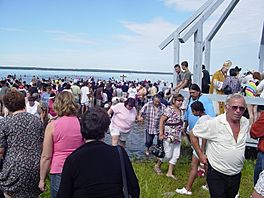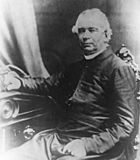Lac Ste. Anne (Alberta) facts for kids
Quick facts for kids Lac Ste. Anne |
|
|---|---|

Pilgrims on Lac Ste. Anne
|
|
| Location | Lac Ste. Anne County, Alberta |
| Coordinates | 53°42′30″N 114°27′37″W / 53.70833°N 114.46028°W |
| Type | eutrophic |
| Primary inflows | Sturgeon River |
| Primary outflows | Sturgeon River |
| Catchment area | 619 km2 (239 sq mi) |
| Basin countries | Canada |
| Surface area | 54.5 km2 (21.0 sq mi) |
| Average depth | 4.8 m (15.7 ft) |
| Max. depth | 9 m (30 ft) |
| Surface elevation | 730 m (2,400 ft) |
| Islands | Farming Island, Horse Island, Castle Island |
| Settlements | Alberta Beach, Sunset Point, Yellowstone, Ross Haven, West Cove, Lac Ste. Anne, Val Quentin |
| Official name: Lac Ste. Anne Pilgrimage National Historic Site of Canada | |
| Designated: | 2004 |
Lac Ste. Anne is a large lake in central Alberta, Canada. It is located in Lac Ste. Anne County, about 75 kilometers (47 miles) west of Edmonton.
The lake covers an area of 54.5 square kilometers (21.0 square miles). It has a maximum depth of 9 meters (30 feet) and an average depth of 4.8 meters (16 feet). Lac Ste. Anne sits at an elevation of 730 meters (2,395 feet) above sea level. It is a eutrophic lake, meaning it is rich in nutrients, which can sometimes lead to lots of plant growth. The Sturgeon River flows into and out of the lake, eventually leading to the North Saskatchewan River.
You can find several islands in the lake. Farming Island and Horse Island are at the western end. The smaller Castle Island and tiny Rock Island are at the eastern tip. The area around the lake is important for farming, especially for growing oats. Many businesses related to recreation also thrive here because of the lake's popularity.
Contents
History of Lac Ste. Anne
Long before settlers arrived, the Nakota Sioux people called this lake Wakamne, which means God's Lake. The Cree First Nations called it Manitou Sakhahigan, meaning Lake of the Spirit.
First Nations and Metis people used to hunt buffalo and fish in Manitou Sakhahigan. Legends told of a huge serpent living in the lake. This serpent was said to create dangerous currents that could easily flip a canoe. Not many people saw the serpent. When the Hudson's Bay Company came, they mistakenly translated the Cree name as "Devil's Lake." However, the Cree name actually means Spirit Lake, showing it was a very sacred place.
Elders from the Alexis Reserve remember their grandparents telling stories. As children, they would look into the clear water, hoping and fearing they might see the legendary monster.
The Lac Ste. Anne Mission
The village of Lac Ste. Anne became one of the first permanent Metis communities in what is now Alberta. It was also the first Catholic mission in the area.
Father Jean-Baptiste Thibault first visited Lac Ste. Anne (then known as Manito-Sakahigan) in 1842. Two years later, in 1844, he started the Mission of Lac Ste. Anne. About 30 French Metis families lived there, having arrived in the 1830s. The church served these Metis and local First Nations people who had become Catholic. Father Thibault renamed the lake Lac Ste. Anne, honoring Saint Anne.
Lac Ste. Anne was a great spot for a mission. It had fertile fields, tall trees for building, and plenty of fish and wildlife. It was also far from the political activities of the Hudson's Bay Company at Fort Edmonton.
The missionaries taught about the Church and also showed people how to farm. They knew the buffalo population was shrinking and wanted the Metis people to become farmers. By 1859, the mission had many cows, horses, and a garden with various crops like wheat, barley, and potatoes.
In 1859, three Grey Nuns traveled from Montreal to the Mission. They arrived on September 24 and were welcomed. The Sisters quickly learned the Cree language, started a school, helped in the gardens, and even painted the church windows to help people focus during services.
The Mission grew very large, with over two thousand people living there. A Hudson's Bay Company post, a school, an orphanage, a North-West Mounted Police barracks, and many other businesses opened. At one point, the mission was even bigger than Fort Edmonton in terms of people and trade.
Father Lacombe, who arrived in 1852, left Lac Ste. Anne in 1861. He went to build a new mission at St. Albert. After he left, the Lac Ste. Anne mission became almost empty, with only a few families and the main church buildings remaining.
The Lac Ste. Anne Pilgrimage
Father Lestanc organized the first pilgrimage to Lac Ste. Anne in 1889. This event honors Saint Anne, whose feast day is on July 26. By 1926, over 5,500 pilgrims attended, many arriving by a special train from Edmonton.
Today, tens of thousands of pilgrims come to the lake from all over North America. Many walk barefoot as a sign of devotion, hoping for healing. You can see crutches and canes left behind at the shrine by pilgrims who say they were healed.
About 30,000 to 40,000 people now attend the annual pilgrimage in the last week of July. During this time, people make promises, pray, and seek forgiveness.
The Lac Ste. Anne Pilgrimage was named a National Historic Site of Canada in 2004. This was because of its important social and cultural meaning.
Lac Ste. Anne Pilgrimage is a site of national historic significance because as early as 1889, Aboriginal people, including Cree, Dene, Blackfoot and Métis, have been coming to Lac Ste. Anne to celebrate the Feast of Saint Anne. Saint Anne embodies, for many Aboriginal peoples, the traditional importance of the grandmother figure. For the Aboriginal people of Western and Northwestern Canada, the pilgrimage site is an important place of social, cultural and spiritual rejuvenation, which are important aspects of the traditional summer gathering.
—Parks Canada
Alberta Beach
A few miles east of Lac Ste. Anne, another part of history unfolded. In 1912, the Alberta Northern Rail built a railroad to what is now Alberta Beach. The railway brought its employees for company picnics and holidays. By 1920, the area became a summer village. They built a dance hall, a large wooden pier, and several cabins. Other companies also started bringing their employees for relaxing getaways.
The demand for this peaceful atmosphere grew so much that the "Moonlight Express" train began. It picked people up in Edmonton on Saturday mornings, took them to Alberta Beach, and brought them back to Edmonton on Sunday nights.
Soon, people started buying land and building their own cabins and small businesses. On January 1, 1999, the Summer Village of Alberta Beach officially became a village. It now has 884 year-round residents, but this number can grow to over 3,000 during long weekends. The village has a hotel and many small businesses. Alberta Beach has grown, but it still keeps the quiet beauty that made it popular in the first place.
Castle Island
In the 1890s, a French Viscount named Charles de Caze began building a castle on a small island. This island is on the northeast shores of Lac Ste. Anne. He named it Constance Island, after his only daughter. The castle was planned to be four stories high and made of stone. Its walls were to be three feet thick, with stone battlements all around the top.
The castle was meant to be his retirement home. Sadly, he died at age 44 and never finished his project. For many years, only two stories of his dream castle remained. They sparked the curiosity of people who stopped to picnic and enjoy the lake views.
About twenty years later, a Mr. Shorty bought the island. He tore down the castle and moved several cabins to Constance Island. During the time of prohibition, it was a great place for parties. Years later, he built a causeway, making it easier to reach the island. Eventually, the island was sold, renamed Castle Island, divided into smaller lots, and became a summer village.
Darwell
In 1912, a rail station also created the community of Darwell. It is located between Lac Ste. Anne and Isle Lake. The name for this station was chosen by chance. An energetic man took out his hymnbook and randomly picked a tune that had the name Darwell in it.
Darwell became known as "Hobo Stop" across Alberta. This was because of a ranch there that never turned away anyone needing shelter. Many unemployed men would ride the train to Darwell. They could get food and a place to stay in exchange for work. It is said that even people wanted by the law found refuge there, leading to many visits from the North-West Mounted Police.
Today, Darwell has a store, a garage, and a school. The old ranch is gone, but the community is still known for its hospitality.
Communities Around the Lake
Several communities are located around Lac Ste. Anne:
- The Alexis Indian Reserve of the Alexis Nakoda Nation is on the northern shore.
- Alberta Beach is on the southeastern shore.
- The Summer Villages of Ross Haven and Yellowstone, along with Corsair Cove and the hamlet of Gunn, are along the northern shore.
- The Summer Villages of Castle Island, Sunset Point, and Val Quentin are near Alberta Beach.
- The Summer Village of West Cove is on the southern shore of the western part of the lake.
Recreation and Fun
Lac Ste. Anne is a great place for outdoor activities!
- There are two campgrounds: one at Alberta Beach and another at Gunn.
- You can also find two golf courses nearby, one at Alberta Beach and one in Ross Haven.
- Two Bible Camps are located on the lakefront: Ross Haven Bible Camp and Sunset Point Christian Camp.
Fishing is very popular here. You can catch fish like whitefish, northern pike, walleye, and yellow perch.
In summer, people enjoy water sports such as sailing, water skiing, and windsurfing. In winter, the lake is perfect for snowmobiling and cross-country skiing.
Images for kids
-
In the arbour during the grand entry, Alexis Pow-wow 2007






